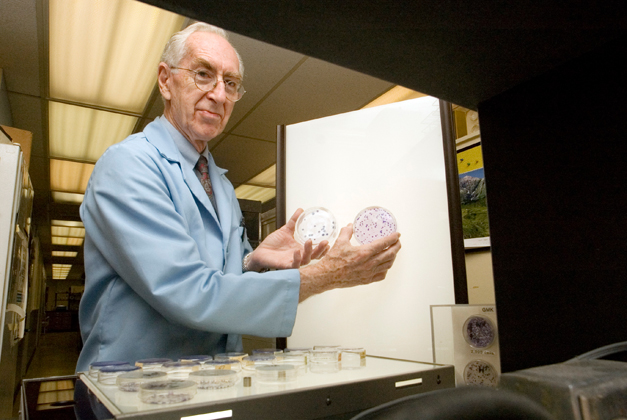
Philip Marcus was once introduced at a scientific symposium as “Mr. Interferon” because of his pioneering research since 1966 on the protein that activates a cell’s anti-viral response.
On Oct. 9, the UConn Board of Trustees Distinguished Professor of Molecular and Cell Biology was named a recipient of the Distinguished Service Award of the International Society for Interferon and Cytokine Research. Although he was not able to attend the meeting in Florence, Italy to receive the award, Marcus, at 84, is still active in research.
He advises two Ph.D. students, John Ngunjiri and Christopher Malinoski, and is working on a major review article that summarizes the research that has absorbed him, his students, and research associate Margaret Sekellick for the past five years: the role of noninfectious biologically active particles in populations of the influenza virus.
Influenza viruses contain many more of these noninfectious biologically active particles than researchers suspected, and Marcus is interested in what role they may play in the course of the disease.
In a career that has spanned more than 60 years of scientific research, Marcus has been associated with a number of breakthroughs:
- In 1955, a paper he wrote as a graduate student at the University of Colorado with biophysicist Theodore Puck, after a discussion with Leo Szilard, the co-inventor of the atomic bomb, described a technique for cloning mammalian cells – the first time this had been done. (The cells they cloned, HeLa cells, were from Henrietta Lacks, the subject of a current bestseller, The Immortal Life of Henrietta Lacks.) He was the first person to clone HeLa cells.
- An “intrinsic interference test” he developed as a junior faculty member at Albert Einstein College of Medicine made it possible to quantitatively detect rubella virus, the cause of an epidemic in the 1960s.
- In 1957, interferon was discovered, and it occupied much of Marcus’s research attention for many years. His Virus and Interferon Research Laboratory at UConn’s Torrey Life Sciences Building became the leading proponent of the theory that double-stranded ribonucleic acid, dsRNA, is the inducer of interferon, and that just one molecule of dsRNA is enough to induce interferon production in a cell, thus activating a cell’s response to a virus.
The chills or fever experienced during a viral infection such as the flu are caused not by the virus, he once explained, but by interferon going to work. Interferon was once touted as a “miracle drug” for cancer. While genetically engineered interferon is used as a therapy for some cancers and some forms of hepatitis, its workings have proved to be more complex than first thought.
For more than 30 years Marcus has taught virology at UConn, and for 18 years he was editor-in-chief of the Journal of Interferon and Cytokine Research. He also directed the Biotechnology Bioservices Center for many years before resigning recently.
And in a recent issue of its magazine, the American Society for Microbiology announced that Marcus is among seven 60-year members of the ASM, which has about 38,000 members.



